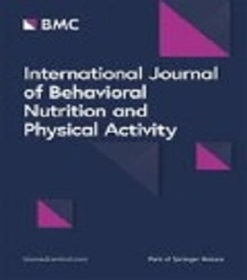从童年到青年时期设备测量的体育活动纵向变化:PANCS 跟踪研究
IF 5.6
1区 医学
Q1 NUTRITION & DIETETICS
International Journal of Behavioral Nutrition and Physical Activity
Pub Date : 2024-03-06
DOI:10.1186/s12966-024-01578-7
引用次数: 0
摘要
目前还缺乏对设备测量的体育活动和久坐时间从儿童期到青年期的变化进行研究的纵向研究。我们的目的是对挪威表面上健康的男性和女性样本中,从儿童期、青春期到青年期,设备测量的体育活动和久坐时间的变化情况进行评估。731名挪威男孩和女孩(49%为女孩)在9岁(2005-2006年)和15岁(2011-2012年)时参加了纵向队列,其中258人在24岁(2019-2021年;包括COVID-19大流行期间)时再次参加。体力活动和久坐时间使用 ActiGraph 加速计进行测量。线性混合模型用于分析体力活动和久坐时间的变化,以及低水平的童年体力活动是否会持续到青年时期(nchange=721;ntracking=640)。最显著的变化发生在 9-15 岁之间,久坐时间增加(150 分钟/天),轻度(125 分钟/天)、中度(16 分钟/天)和剧烈运动(8 分钟/天)的时间减少。只有在 15-24 岁之间观察到较小的变化。从童年到青年时期,中强度体力活动的变化在不同性别、基线体重指数三等分和基线峰值摄氧量三等分的亚组之间存在差异。虽然追踪模型表明,从儿童期到青年期,体力活动的绝对稳定性较低,但与基线时属于较高三个四分位数的儿童相比,9 岁时处于中度到剧烈体力活动(OR:1.88;95%CI:1.23,2.86)和总体力活动(OR:1.87;95%CI:1.21,2.87)最低四分位数的儿童在 24 岁时处于这些四分位数的可能性要高出近 90%。我们发现,9 岁至 15 岁期间,体力活动大幅减少,久坐不动的时间增加。与以往主要使用自我报告的体力活动量的研究相反,我们在青少年期和青年期之间观察到的变化很小。最不活跃的儿童更有可能成为最不活跃的成年人,因此可以作为早期干预的目标。本文章由计算机程序翻译,如有差异,请以英文原文为准。
Longitudinal changes in device-measured physical activity from childhood to young adulthood: the PANCS follow-up study
There is a lack of longitudinal studies examining changes in device-measured physical activity and sedentary time from childhood to young adulthood. We aimed to assess changes in device-measured physical activity and sedentary time from childhood, through adolescence, into young adulthood in a Norwegian sample of ostensibly healthy men and women. A longitudinal cohort of 731 Norwegian boys and girls (49% girls) participated at age 9 years (2005–2006) and 15 years (2011–2012), and 258 of these participated again at age 24 years (2019–2021; including the COVID-19 pandemic period). Physical activity and sedentary time were measured using ActiGraph accelerometers. Linear mixed models were used to analyse changes in physical activity and sedentary time and whether low levels of childhood physical activity track, i.e., persist into young adulthood (nchange=721; ntracking=640). The most prominent change occurred between the ages of 9 to 15 years, with an increase in sedentary time (150 min/day) and less time spent in light (125 min/day), moderate (16 min/day), and vigorous physical activity (8 min/day). Only smaller changes were observed between the ages of 15 and 24 years. Changes in moderate-to-vigorous physical activity from childhood to young adulthood differed between subgroups of sex, tertiles of body mass index at baseline and tertiles of peak oxygen uptake at baseline. While the tracking models indicated low absolute stability of physical activity from childhood to young adulthood, children in the lowest quartiles of moderate-to-vigorous (OR:1.88; 95%CI: 1.23, 2.86) and total physical activity (OR: 1.87; 95%CI: 1.21, 2.87) at age 9 years were almost 90% more likely to be in these quartiles at age 24 years compared to those belonging to the upper three quartiles at baseline. We found a substantial reduction in physical activity and increase in time spent sedentary between age 9 and 15 years. Contrary to previous studies, using mainly self-reported physical activity, little change was observed between adolescence and young adulthood. The least active children were more likely to remain the least active adults and could be targeted for early intervention.
求助全文
通过发布文献求助,成功后即可免费获取论文全文。
去求助
来源期刊
CiteScore
13.80
自引率
3.40%
发文量
138
审稿时长
4-8 weeks
期刊介绍:
International Journal of Behavioral Nutrition and Physical Activity (IJBNPA) is an open access, peer-reviewed journal offering high quality articles, rapid publication and wide diffusion in the public domain.
IJBNPA is devoted to furthering the understanding of the behavioral aspects of diet and physical activity and is unique in its inclusion of multiple levels of analysis, including populations, groups and individuals and its inclusion of epidemiology, and behavioral, theoretical and measurement research areas.

 求助内容:
求助内容: 应助结果提醒方式:
应助结果提醒方式:


